
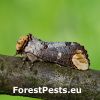
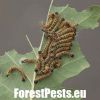
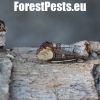
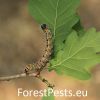
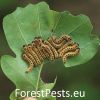


















 Show all photos in album
Insert for comparison
We will identify your pest
Add pictures of this species
Show all photos in album
Insert for comparison
We will identify your pest
Add pictures of this species
Phalera bucephala
Buff-tip moth
Description
Both larvae and moths are unmistakably coloured. Egg batches of 50 eggs are attached to the underside of the leaves in May-July. The larvae feed gregariously first on the lower leaf epidermis, and then later they devour entire leaves. In fall the fully-grown, 4-6 cm long larvae enter the soil and spend wintertime as pupae. Populations are usually univoltine, but in southern regions bivoltine. The leaves affected by the early instar larvae turn brown. The older larvae can defoliate shoots and twigs, which may result in shoots dying back and trees weakening. Young trees and shrubs are preferred. It occurs in broadleaved forests, plantations, tree nurseries, amenity trees, parks and gardens.
Symptom
Colorful larvae on leaves.
Tree Species: Elm, Birch, Oak, Maple, Lime, Poplar, Willow
Part of a plant- attacked: Leaf / Needle
Pest significance: Less harmful
Pest Category: Insects
Invasive Species: No
Present in EU: Yes
Add comment: Phalera bucephala
Location map: Phalera bucephala
print viewLegend:

Expert verified points

Unverified points







